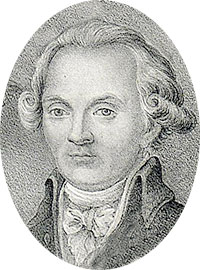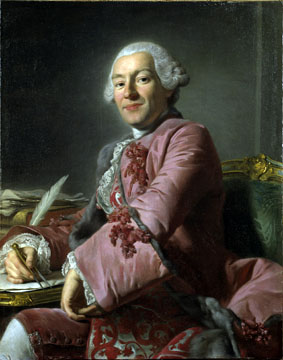
Baron Gustaf Adolf Reuterholm, was a Swedish statesman. He acted as the de facto regent of Sweden during the minor regency of Gustav IV Adolf of Sweden between 1792 and 1796.

The Royal Swedish Academy of Music, founded in 1771 by King Gustav III, is one of the Royal Academies in Sweden. At the time of its foundation, only one of its co-founder was a professional musician, Ferdinand Zellbell the Younger. The Academy is an independent organization, which acts to promote the artistic, scientific, educational and cultural development of music. Fredrik Wetterqvist is director of the Academy.

The History of Sweden from 1772 through 1809 is better known as the Gustavian era of Kings Gustav III and Gustav IV, as well as the reign of King Charles XIII of Sweden.
Prins Eugens Waldemarsudde, is a museum located on Djurgården in central Stockholm. The name is composed of Waldemar, an Old German noble male name, and udde, meaning cape. It is derived from a historical name of the island Djurgården, Valmundsö

Tullgarn Palace is a royal summer palace in the province of Södermanland, south of Stockholm, Sweden. Built in the 1720s, the palace offers a mixture of rococo, Gustavian and Victorian styles. The interior design is regarded as one of Sweden's finest.

Strömsholm Palace, sometimes called Strömsholm Castle, is a Swedish royal palace. The baroque palace is built on the site of a fortress from the 1550s, located on an island in the Kolbäcksån river at the west end of Lake Mälaren. The palace has interiors from the 18th century and an important collection of Swedish paintings.

Swedish art refers to the visual arts produced in Sweden or by Swedish artists. Sweden has existed as a country for over 1,000 years, and for times before this, as well as many subsequent periods, Swedish art is usually considered as part of the wider Nordic art of Scandinavia. It has, especially since about 1100, been strongly influenced by wider trends in European art. After World War II, the influence of the United States strengthened substantially. Due to generous art subsidies, contemporary Swedish art has a big production per capita.

Hedwig Elisabeth Charlotte of Holstein-Gottorp was Queen of Sweden and Norway as the consort of King Charles XIII and II. She was also a famed diarist, memoirist and wit. She is known by her full pen name (above), though her official name as queen was Charlotte (Charlotta).

Rosersberg Palace is one of the Royal Palaces of Sweden. Situated on the shores of Lake Mälaren, on the outskirts of Stockholm, it was built in the 1630s by the Oxenstierna family and became a royal palace in 1762, when the state gave it to Duke Karl, the younger brother of Gustav III of Sweden.
Ulrika Åberg (1771–1852) was a Swedish ballerina. She was active in the Royal Swedish Ballet in 1782-95. She was one of the first native ballet dancers in the Royal Swedish Ballet.

Mariane Theresia Sophie Stebnowska also called Zofia Stępkowska or Stempkosta was a Swedish opera singer and harpist of Polish origin. She has been referred to as one of the more notable stage artists of the Gustavian era Royal Swedish Opera. She was the maternal grandmother of the famous ballerina Marie Taglioni.

Kavlås Castle is a manor house in Hömbs parish in Tidaholm Municipality in Västra Götaland County, Sweden.

Mem Castle is located at Tåby parish, Norrköping Municipality in Östergötland County Sweden. It is situated near the mouth of the Göta Canal.
Bertil H. van Boer is an American musicologist, composer, conductor and violist.

King Gustav III of Sweden and His Brothers is an oil painting by the Swedish portrait painter Alexander Roslin showing Gustav with his two brothers, Prince Frederick Adolf and Prince Charles, later Charles XIII of Sweden. Frederick is standing, Gustav is sitting to the left, and Charles is to the right. The painting is in the collection of the Swedish National Museum.

Events from the year 1810 in Sweden

Events from the year 1789 in Sweden

Events from the year 1776 in Sweden

Events from the year 1754 in Sweden

The Gustavians were a political faction in the Kingdom of Sweden who supported the absolutist regime of King Gustav III of Sweden, and sought after his assassination in 1792 to uphold his legacy and protect the interests of his descendants of the House of Holstein-Gottorp.
















